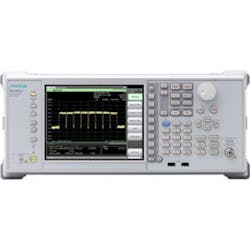Richardson, TX. Anritsu has introduced the MS2850A signal analyzer, which the company said can cost efficiently and accurately evaluate 5G signals with the 800-MHz modulation bandwidth (8 x 100 MHz channels) associated with 5G designs. With analysis bandwidth up to 1 GHz, the MS2850A provides wireless equipment manufacturers and mobile operators with a comprehensive and affordable tool to evaluate base stations and terminals as well as satcom and broadband communications equipment.
Engineers can use the MS2850A, which has a standard analysis bandwidth of 255 MHz that can be extended to 1 GHz, to evaluate Tx performance. The MS2850A supports 5G standards currently under development by 3GPP, as well as legacy technologies such as LTE, W-CDMA, TD-SCDMA, and GSM. Anritsu said the MS2850A fills a market void for an economical solution to accurately measure infrastructure under development for the emerging 5G market, as well as for other communications applications that have similar requirements, such as larger data capacity at faster speeds.
Two models—with frequency coverage up to 32 GHz and 44.5 GHz, respectively—are available, each with the noise-figure (NF) and phase-noise performance required for 5G testing. Featuring high dynamic range and exceptional flatness, engineers can use the MS2850A to accurately evaluate wideband wireless signals associated with 5G designs. At 28 GHz, the MS2850A has amplitude flatness of ±1.2 dB and phase flatness of 5° p-p at a 500-MHz center frequency. The analyzers alsoThree software packages are available for the MS2850A to precisely measure critical 5G characteristics. The CP-OFDM modulation software leverages the high dynamic range of the MS2850A to achieve EVM performance of less than 1%. Other measurements that can be conducted with the MS2850A when the software is installed include uplink and downlink signal frequency error and power. A multicarrier analysis function improves measurement and testing efficiency of downlink measurements by shortening times for relative comparisons of characteristics for each carrier, as well as timing errors and general characteristics for all mobile operators.
https://www.anritsu.com/en-US/test-measurement/products/ms2850a


